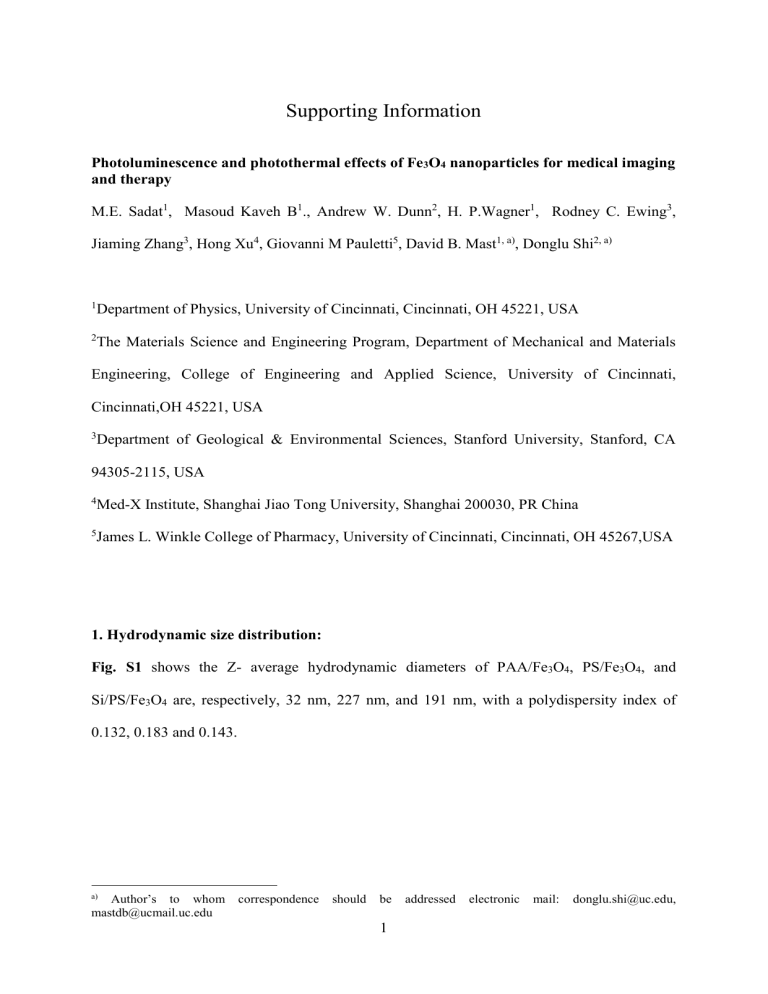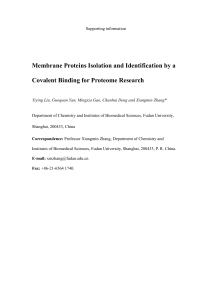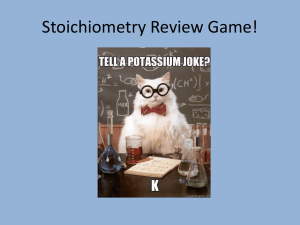Supplementary information_APL_sadat_dshi

Supporting Information
Photoluminescence and photothermal effects of Fe
3
O
4
nanoparticles for medical imaging and therapy
M.E. Sadat
1
, Masoud Kaveh B
1
., Andrew W. Dunn
2
, H. P.Wagner
1
, Rodney C. Ewing
3
,
Jiaming Zhang 3 , Hong Xu 4 , Giovanni M Pauletti 5 , David B. Mast 1, a) , Donglu Shi 2, a)
1
Department of Physics, University of Cincinnati, Cincinnati, OH 45221, USA
2
The Materials Science and Engineering Program, Department of Mechanical and Materials
Engineering, College of Engineering and Applied Science, University of Cincinnati,
Cincinnati,OH 45221, USA
3
Department of Geological & Environmental Sciences, Stanford University, Stanford, CA
94305-2115, USA
4
Med-X Institute, Shanghai Jiao Tong University, Shanghai 200030, PR China
5
James L. Winkle College of Pharmacy, University of Cincinnati, Cincinnati, OH 45267,USA
1. Hydrodynamic size distribution:
Fig. S1 shows the Z- average hydrodynamic diameters of PAA/Fe
3
O
4
, PS/Fe
3
O
4
, and
Si/PS/Fe
3
O
4
are, respectively, 32 nm, 227 nm, and 191 nm, with a polydispersity index of
0.132, 0.183 and 0.143.
a) Author’s to whom correspondence should be addressed electronic mail: donglu.shi@uc.edu, mastdb@ucmail.uc.edu
1
Figure S1: Hydrodynamic size distribution of magnetite nanoparticle samples, measured at a concentration of 0.1 mg/mL.
2. Fluorescence spectroscopy and fluorescence imaging:
Fluorescence emission spectra of all samples were taken with F-2500 fluorescence spectrophotometer. For comparison, the concentration of all samples was set at 0.25 mg/mL.
Excitation and emission slits used were 5 nm and 20 nm respectively. All spectra were collected at 60 nm/min scan speed and photomultiplier voltage was set to 700 V. Fig. S2(a-b) shows the fluorescence emission spectra of PAA/Fe
3
O
4
and PS/Fe
3
O
4
, where an intense peak at ~525 nm (2.36 eV) with a shoulder ~465 nm (2.66 eV) was observed for both samples. The peak at 525 nm is consistent with the photoluminescence (PL) measurements, where a peak near 540 nm was assigned to the energy gap of crystal field splitting (2.2 eV) of octahedral site. According to the band structure model of Fe
3
O
4
, the peak at 465 nm can be attributed to the electron transitions into the defect sites. It is note that, the fluorescent intensity of
PS/Fe
3
O
4
is about fifteen folds higher than that of PAA/Fe
3
O
4
, which is also consistent with the PL measurements. Fluorescent spectra of all the nanoparticle samples collected at the same excitation wavelength shows the same structure described above [ Fig. S2(c)]. Figure
S2(d) shows the normalized fluorescent spectra of all samples collected with the excitation
2
wavelength of 250 nm, 350 nm and 400 nm. The purpose of using different excitation was to cut off the second order light from the excitation source and to observe fluorescent signal of
Fe
3
O
4
over broad range of (300- 780) nm.
Fig. S3 shows the bright field and corresponding fluorescence images of Beads/Fe
3
O
4 and PS/Fe
3
O
4
. Fluorescence images were taken with Zeiss LSM 710 confocal microscope with 488 nm excitation and (494-680) nm band pass filter. As can be seen from Fig. S3(b
&d), Beads/Fe
3
O
4
and PS/Fe
3
O
4
exhibit green fluorescence, which are consistent with the fluorescent spectra and photoluminescence measurements.
Figure S2: Fluorescence emission spectra of (a) PAA/Fe
3
O
4
; (b) PS/Fe
3
O
4
of 0.25 mg/mL, measured at an excitation wavelength of 350 nm, with absolute emission intensity; (c) fluorescent emission spectra of all samples at the same excitation but intensity is plotted in arbitrary units, and (d) normalized fluorescence emission spectra of all samples collected at an excitation of 250 nm, 350 nm, and 400 nm.
3
Figure S3: (a) Bright field image; (b) corresponding fluorescence image of 5
m
Beads/Fe
3
O
4
sample; (c) bright field image, and (d) corresponding fluorescence image of
PS/Fe
3
O
4
. All images were taken at 488 nm laser excitation with emission filter of 494 – 680 nm.
3. Photoluminescence spectroscopy
In order to evaluate band structure of Fe
3
O
4
nanoparticles, photoluminescence (PL) measurements were completed on different Fe
3
O
4
nanoparticle sample. A continuous-wave
(cw) 407 nm solid-state crystal laser is used to excite the ensemble of nanoparticles inside a
0.35 ml quartz crystal cuvette. The cuvette has a path length of 10 mm, inside width of 1 mm, and it contains 0.25 ml of the sample solution. The incident beam of laser is 2 mm in diameter and is focused on the sample using a lens with a focal length of 150 mm. resulting in an excitation area of 12
10
-6
cm
2
. All measurements were performed at room temperature.
The PL signal of the nanoparticles was detected using a spectrometer and amplified by a
4
GaAs photomultiplier. A long pass filter (GG 420) was used before the spectrometer in order to cut-off any laser scattering.
Figure S4: (a) PL spectra of Fe
3
O
4
nanoparticle systems measured at a power of 1.5 mW with
407 nm solid state laser; red lines in the figure are experimentally measured spectra, solid lines are the Gaussian fit to the PL peaks, and the corresponding cumulative fit peaks are shown as the black dashed lines in the spectra. (b) PL spectra (cumulative fit peak) of the
PS/Fe
3
O
4
nanosphere system respectively measured by using a power of 1.5 mW and 4.5 mW solid state laser (
= 407 nm). Note that the PL counts consistently increase with power but the peak position remains stationary.
4. Photothermal heating measurement set up and the thermal imaging:
In order to determine the photothermal transduction efficiency of each nanoparticle solution, a fiber-coupled continuous wave diode-laser of wavelengths 808 nm was used to irradiate the sample of 200 L and at 1 mg/mL concentrations. Heating and cooling behaviors of the
5
samples were monitored by placing a thermal imaging infrared camera (FLIR T640) above the 48 well plate sample holder. The laser spot size was controlled in such a way that the illuminated area was the same as the area of the single well (~1 mm) of 48 well plates, which gives an average laser intensity of 1.07 W/cm 2 . To maintain the physiological temperature at
37 o
C and to reduce the heat dissipation to the environment, all temperature measurements were completed by mounting the sample holder on the top of a hot plate and by placing the whole apparatus inside a Fisher scientific desiccator cabinet. A schematic of the experimental set up and thermal images of the Fe
3
O
4
nanoparticles measured with another diode laser of wavelength 785 nm and intensity 0.998 W/cm 2 is shown in Figure S5 and S6 . The sample concentration was kept at 0.5 mg/mL to perform the measurement.
Figure S5: Schematic of the photothermal heating measurement system.
Figure S6: Thermal images of the sample were taken while illuminated with 785 nm laser light at an intensity of 0.998 W/cm
2
, where the nanoparticle solution was placed in the right well (spot 1). As can be seen from the figures, temperature of spot 1 increases from 35.6
O
C to
6
42.6
0
C after 2 min exposure to the 785 nm laser. After 10 min of exposure, the temperature is saturated at 45.7
O
C, while that of the rest (Spot 2 and 3) is maintained at ~ 36 o
C.
5. Calculation of real refractive index from the Kramers-Kronig relations:
The refractive index was determined by numerically integrating the absorption spectrum using the Kramers-Kronig relations as follows
1
:
n (
)
c
P
2
1
(
(
)
2
)
(
)
2 d (
)
(S1) where, P is the Cauchy principal value integral,
(
) is the change in absorption coefficient, c is the speed of light, and limit of integration is set as such that
1
2
Figure S7: Real refractive index as a function of wavelength was calculated by numerically integrating the experimentally measured absorbance spectra using Kramers-Kronig relation.
The limit of integration was set as 1 .
2405
4 .
135 .
7
In order to calculate the extinction (Q ext
), absorption (Q abs
), and scattering (Q sca
) efficiencies, the Mie theory was employed, which is valid for spheres of any size. Upon illumination of light, the outgoing scattered wave is expanded as an infinite series of vector spherical harmonics, which can be expressed by the following equations 2 :
Q ext
2 x
2
n
1
( 2 n
1 ) Re[ a n
b n ]
(S2)
Q sca
2 x
2 n
1
( 2 n
1 )[ a n
2 b n
2
]
Q abs
Q ext
Q sca
(S3)
(S4) where a n
and b n
are the coefficients, x
2
n m ed a
o is the size parameter with a being the mean radius of the particles, n m ed
is the refractive index of the media, and
o is the vacuum wavelength. Numerical values of Q ext
, Q abs
and Q sca
were calculated as a function of wavelength using the code “Mie-Plot” written by Philip Laven 3
.
6. Fourier Transformed Infrared Raman (FTIR) and Raman Spectroscopy:
FTIR spectra of all the samples show the characteristic absorption band at 580 cm -1 corresponding to the (Fe-O) stretching vibration of the tetrahedral site of magnetite. Magnetite has another absorption band at 430 cm
-1
due to torsional vibrational mode of Fe on the octahedral site
4
, which was not resolved due to limited spectral range.
8
PAA/Fe
3
O
4
PS/Fe
3
O
4
Si/PS/Fe
3
O
4
632
572
400 600 800 1000
Wavenumber (cm
-1
)
1200
Figure S8: FTIR spectra of the magnetite (Fe
3
O
4
) nanoparticle samples.
The nanoparticle solution was first dried onto a glass slide and the Raman spectra were collected at room temperature using an inVia Raman microscope (Renishaw, Illinois,
USA) with a 514 nm excitation laser. The spot size of the laser was approximately ~1
m after passing through a LX50 objective. The grating of the spectrometer was 1800 l/mm. The acquisition time for all measurements was 120 s with a single scan. All the spectra were obtained using the Renishaw Wire 3.3 software. A Philips SPC1030NC camera was mounted on the top to take the picture of the samples before and after laser illumination.
Raman experimental results show all the characteristic peaks of hematite measured at a 100 % laser power, as shown in Figure S9 . The image of the sample, taken during the
Raman measurements, shows sample degradation with a bright spot after laser irradiation
( Figure S9 b-e ). A report by Slavov et al. showed the phase transformation from magnetite to hematite upon irradiation of 1.93 mW laser. But the same phase transformation required a much higher power of 9 mW in a colloidal solution
5
. The hematite peaks also appear at a much lower power in the Raman spectra (10%) (not shown). For PS/Fe
3
O
4
and Si/PS/Fe
3
O
4
, however, the peak position is shifted to lower wavenumbers indicating the particle size
9
dependence of Raman characteristics. Several reports based on a variety of spectroscopic techniques have shown an absorption onset of hematite at 3.1 eV, 2.2 eV and 1. 8 eV, indicating the structural similarities between magnetite and hematite
6-9
.
(a)
Figure S9: (a ) Raman spectra of all samples measured at 100% laser power for a120 sec acquisition time with LX50 objective. (b-c) show the optical images of the samples; (b) before; (c) after laser illumination of PAA/Fe
3
O
4
; (d) and (e) show the digital images of the samples; (d) before, and (e) after laser illumination of PS/Fe
3
O
4
, where the bright spot in the image indicates the surface damage of the sample due to 100% laser exposure.
References
1. Kenji Nakamura, Akira Shimizu, Kazuhito Fujii, Masanori Koshiba and Kazuya Hayata,
Quantum Electronics, IEEE Journal of 28, 1670 (1992).
2. A. Quirantes and AV Delgado, J. Phys. D 30, 2123 (1997).
3. P. Laven, PhilipLaven.com 10, (2006).
4. Ying-Sing Li, Jeffrey S. Church and Andrea L. Woodhead, J Magn Magn Mater 324, 1543
(2012).
10
5. L. Slavov, MV Abrashev, T. Merodiiska, Ch Gelev, RE Vandenberghe, I. Markova-Deneva and I. Nedkov, J Magn Magn Mater 322, 1904 (2010).
6. Jae Young Kim, Ganesan Magesh, Duck Hyun Youn, Ji-Wook Jang, Jun Kubota, Kazunari
Domen and Jae Sung Lee, Scientific reports 3, (2013).
7. Z. Zhang, C. Boxall and GH Kelsall, Colloids Surf. Physicochem. Eng. Aspects 73, 145
(1993).
8. Colin Boxall, Geoff Kelsall and Zhao Zhang, Journal of the Chemical Society, Faraday
Transactions 92, 791 (1996).
9. Lionel Vayssieres, Conny Sathe, Sergei M. Butorin, David K. Shuh, Joseph Nordgren and
Jinghua Guo, Adv Mater 17, 2320 (2005).
11







